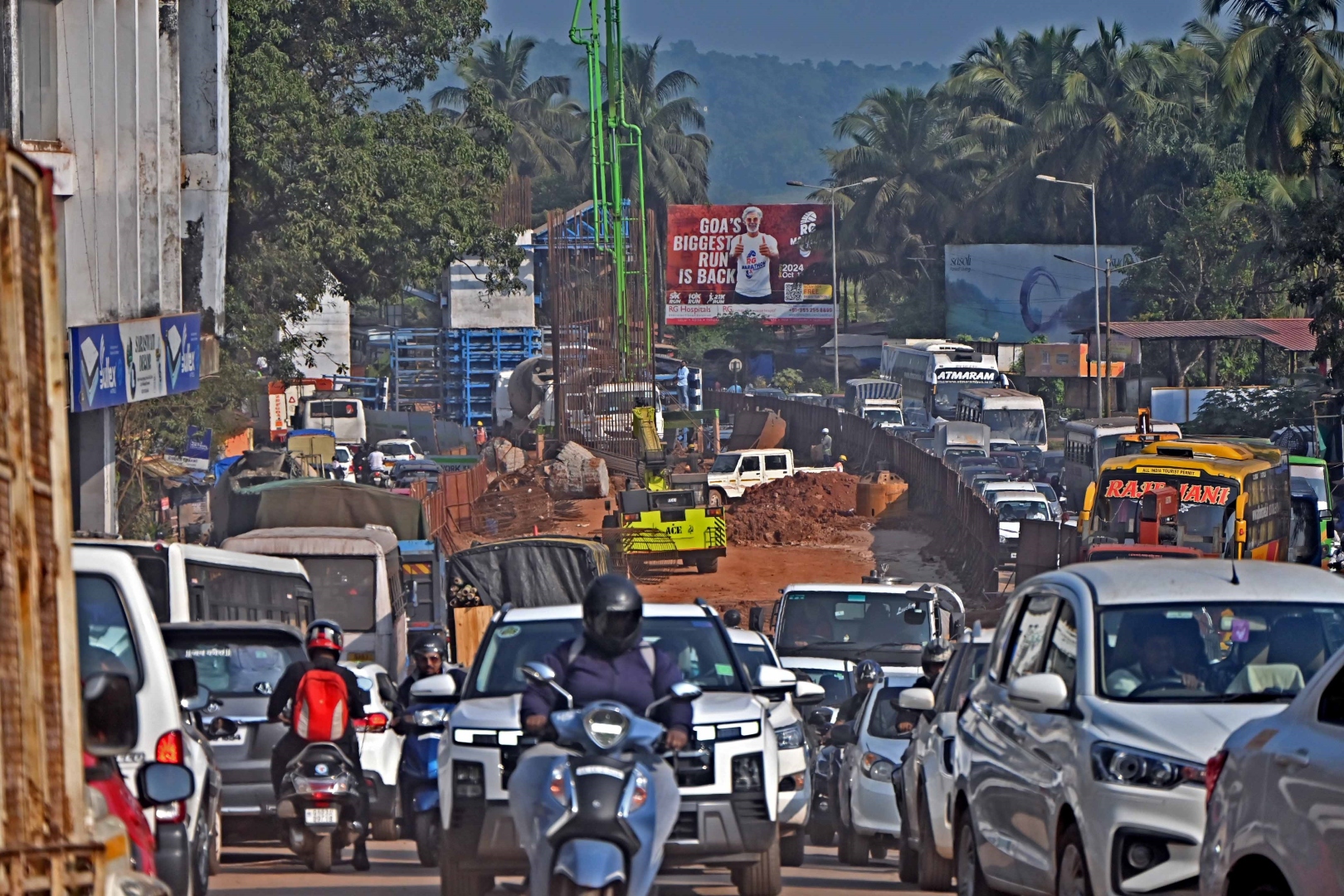
The work on the Porvorim elevated corridor has made the commute on the under-construction highway a nightmare for commuters.
Photo Credits: Narayan Pissurlenkar
MAPUSA
The year 2024 will go down as one of the most challenging for motorists and commuters in Bardez, as roads across the taluka witnessed unprecedented deterioration, sparking public outrage, protests and debates on accountability.
The state of the roads has been a recurring grievance, but this year saw new lows, especially in Siolim, Saligao, Mapusa, and Aldona constituencies.
Chief Minister Pramod Sawant was forced to intervene during the Ganesh Chaturthi festivities, summoning senior PWD officials and issuing stern warnings to contractors and engineers. However, despite assurances, many roads remain in a deplorable state.
Development projects turn roads into rubble
Ironically, much of the damage stemmed from development projects. The laying of underground electricity cabling and new water pipelines wreaked havoc on road surfaces.
Coastal areas like Siolim faced the brunt of this disruption, particularly the Assagao Major District Road (MDR), which became nearly impassable.
Residents described the 3-5 km stretch as a "war zone," with layers of rubble replacing what was once a motorable road. During the monsoons, the situation worsened, leaving buses and cars stranded and prompting bus owners to stage impromptu protests.
Villagers, led by Sarpanch Hanumant Naik, threatened to file a PIL, but the legal action never materialised. To date, the road remains a dusty, bumpy nightmare, with vehicles crawling at a snail’s pace and residents bearing the brunt of the dust pollution.
The Verla-Canca road leading to Anjuna, a popular route for tourists, also suffered immensely.
The Siolim-Marna MDR and several roads in Anjuna’s coastal belt deteriorated significantly, tarnishing the area’s reputation as a prime tourist destination.
Saligao and Mapusa: A similar story
The roads at Arrarim and Sonarbhat in Saligao painted a similarly bleak picture. Pre-monsoon pipeline work by the Water Resources Department (WRD) left the roads riddled with potholes and uneven surfaces.
Some private bus operators even ceased operations on the Calangute-Saligao-Mapusa route, citing safety concerns. Public protests and petitions to the Consumer Conciliation Committee (CCC) followed, but relief was minimal.
Even as the PWD began hot mixing some roads two days ago, residents criticised the thin-layered approach, fearing it wouldn’t withstand another monsoon.
In Mapusa, stretches like the Karasvaddo underpass and the main district road near the Bodgeshwar temple were among the worst affected.
Despite years of complaints, these roads remain neglected, forcing daily commuters to navigate treacherous terrain. Angod’s internal roads also remain unrepaired, although partial restoration has been done elsewhere.
In Aldona, the underground cabling work undertaken by the power department caused extensive damage to roads, adding to the woes of residents. The slow pace of restoration has left many questioning the efficacy of government planning and accountability.
Accountability and planning
The chaos has highlighted a glaring issue: the lack of accountability and coordination among departments. The failure to repair roads before the monsoon season was a recurring theme, as contractors seemed to prioritise deadlines over quality.
Many locals believe stricter enforcement of timelines is essential. “Departments should be mandated to complete work and restore roads by May 15. Beyond that, no digging should be allowed,” a frustrated resident of Mapusa opined.
As 2024 comes to a close, the condition of Bardez roads remains a sore point. While some efforts have been made to patch up the damage, they are seen as superficial at best.
Residents are demanding long-term solutions, stricter monitoring of development projects, and quality restoration of roads. The question remains: will 2025 bring relief to Bardez, or will it be another year of potholes, protests and broken promises? Only time will tell.
After an extended monsoon season that lasted until late October, the Public Works Department (PWD) has begun repairing potholes and patching up broken roads across the State.
In some areas, hot mixing work has also commenced to restore damaged road surfaces. PWD officials acknowledged that the condition of roads has deteriorated significantly this year, mainly because of ongoing development projects such as underground power cabling, water pipeline installation and sewerage network expansion.
Senior PWD engineers, speaking on condition of anonymity, pointed to a lack of coordination between various departments as a key reason for the delays in repairing roads after digging work is completed.
"Earlier, contractors involved in development works would deposit funds directly with the PWD for road restoration. This allowed us to carry out repair work immediately without the need for a lengthy tendering process," a senior engineer explained.
However, the current system requires the PWD to prepare cost estimates, secure technical and administrative approvals, and complete the tendering process before issuing a work order.
"This bureaucratic process takes at least a year, causing significant delays in road repairs. Meanwhile, residents continue to suffer due to the poor condition of the roads," the engineer added.
The PWD has urged better coordination among departments to expedite road restoration efforts, ensuring that repairs are carried out promptly once development projects are completed.